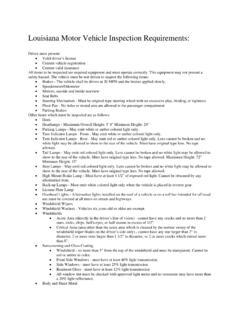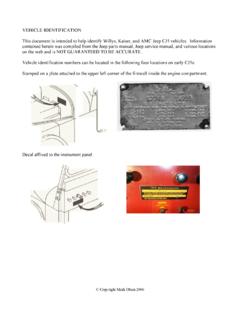Transcription of Louisiana Motor Vehicle Inspection Requirements
1 Louisiana Motor Vehicle Inspection Requirements : Driver must present: Valid driver s license Current Vehicle registration Current valid insurance All items to be inspected are required equipment and must operate correctly. This equipment may not present a safety hazard. The Vehicle must be test driven to inspect the following items: Brakes - The Vehicle shall be driven at 20 MPH and the brakes applied slowly. Speedometer/Odometer Mirrors, outside and inside rearview Seat Belts Steering Mechanism - Must be original type steering wheel with no excessive play, binding, or tightness Floor Pan - No holes or rusted area are allowed in the passenger compartment Parking Brakes Other items which must be inspected are as follows: Horn Headlamps - Maximum Overall Height: 5' 4" Minimum Height: 24" Parking Lamps - May emit white or amber colored light only. Turn Indicator Lamps - Front - May emit white or amber colored light only.
2 Turn Indicator Lamps - Rear - May emit red or amber colored light only. Lens cannot be broken and no white light may be allowed to show to the rear of the Vehicle . Must have original type lens. No tape allowed. Tail Lamps - May emit red colored light only. Lens cannot be broken and no white light may be allowed to show to the rear of the Vehicle . Must have original type lens. No tape allowed. Maximum Height: 72" Minimum Height: 15" Stop Lamps - May emit red colored light only. Lens cannot be broken and no white light may be allowed to show to the rear of the Vehicle . Must have original type lens. No tape allowed. High Mount Brake Lamp - Must have at least 4 1/2" of exposed red light. Cannot be obscured by any aftermarket item. Back-up Lamps - Must emit white colored light only when the Vehicle is placed in reverse gear. License Plate Lamp Overhead Lights - Aftermarket lights installed on the roof of a Vehicle or on a roll bar intended for off-road use must be covered at all times on streets and highways.
3 Windshield Wipers Windshield Washers - Vehicles six years old or older are exempt. Windshields Acute Area (directly in the driver s line of vision) - cannot have any cracks and no more than 2 stars, nicks, chips, bull's-eyes, or half moons in excess of 1/2". Critical Area (area other than the acute area which is cleaned by the normal sweep of the windshield wiper blades on the driver s side only) - cannot have any star larger than 2" in diameter, 2 or more stars larger than 1 1/2" in diameter, or 2 or more cracks which extend more than 8". Sunscreening and Glass Coating Windshield - no more than 5" from the top of the windshield and must be transparent. Cannot be red or amber in color. Front Side Windows - must have at least 40% light transmission Side Windows - must have at least 25% light transmission Rearmost Glass - must have at least 12% light transmission All window tint must be checked with approved light meter and no sunscreen may have more than a 20% light reflectance.
4 Body and Sheet Metal Fenders - Tire cannot extend more than 1" beyond fenders. Bumpers Doors and Windows Hood Latch Wheels and Tires - Must have at least 2/32" of tread measured in any 2 adjacent major grooves. No knots, bulges, sidewall cracks or tread exposure allowed. Suspension and Shock Absorbers Exhaust System - No excessive noise, smoke or fumes Emission Items A visual Inspection must be conducted on the following items: 1980-1983 Passenger cars and light trucks Catalytic Converter Air Injection System PCV Valve EGR Valve Choke System Thermostatic Air Intake System 1984 and later passenger cars and light trucks All of the above as well as: Oxygen Sensor Misfire Special items to be inspected are as follows: Gas Cap Pressure PROGRAM DESCRIPTION In response to statutory Requirements of the federal Clean Air Act Amendments of 1990, the Louisiana Legislature (by Act 576 of the 1999 Regular Session) authorized a low enhanced Inspection and Maintenance (I/M) program for the control and abatement of Motor Vehicle emissions in the five-parish Baton Rouge ozone non-attainment area.
5 Only vehicles registered within this five-parish area consisting of Ascension, East Baton Rouge, Iberville, Livingston, and West Baton Rouge parishes will be subject to this rule. The new emissions testing, which began on January 1, 2000, is performed as a part of annual safety inspections on vehicles that are gasoline-fueled and have a gross Vehicle weight rating (gvwr) of 10,000 pounds or less. Currently, the annual safety and emissions Inspection consists of inspecting the Vehicle 's safety equipment, a visual anti-tampering check of the emissions system, and a gas cap integrity test. In addition to the above Requirements , On-Board Diagnostic (ODB II) testing was implemented in July 2002. Enforcement of program provisions and collection of fees for the Vehicle I/M program is governed by the Department of Public Safety and Corrections (DPS), Office of State Police, Safety Enforcement Section, with LDEQ providing oversight, data collection support, and liaison activities.
6 Pursuant to : 1306 (C), DPS has promulgated a rule (LAC 55 ), which implements the Requirements of the Vehicle I/M program. Motor Vehicle emissions & Air Pollution Air pollution comes from factories, businesses, consumer products, cars, trucks and buses. Pollution from vehicles causes two of our worst air pollution problems, smog, or low-level ozone, and carbon monoxide. Ozone is a colorless gas, which is composed of three oxygen atoms linked together. When found in the upper atmosphere, it is a natural barrier to the harmful rays of the sun. When found at ground level, it can be a hazard to the health of humans, animals and plants. Ozone is formed when volatile organic compounds (VOCs) and nitrogen oxides (NOx) react during a warm, sunny day. Industry, gasoline fumes, Vehicle exhaust, chemical solvents, and natural resources generally release VOCs and NOx which are known to cause ozone at ground level . Ozone affects ones' health by damaging lung tissue and making them more susceptible to infections.
7 Ozone is also known to aggravate already existing health problems, such as asthma, heart disease and emphysema. It can also inhibit the growth of plants, cause damage to crops, crack the seal of rubber and adhesives, and cause dyes to fade. On days that ozone levels are high (hot, summer days, with no wind), residents should try to reduce the amount of time spent outdoors and should avoid most outdoor exercise. People with asthma or other respiratory problems should be especially careful of exposure on bad days. Information on ozone levels on particular days can be obtained from the DEQ web site at ozone from the DEQ Air Quality Update Line at (225)-219-3543. Other ozone information can also be found at irnow/ o zone2. html . Carbon Monoxide (CO) is a colorless, odorless, poisonous gas. A product of incomplete burning of hydrocarbon-based fuels, carbon monoxide consists of a carbon atom and an oxygen atom linked together. Carbon Monoxide forms when there is an incomplete combustion of fuel and is emitted from the tailpipes of vehicles.
8 When vehicles are not tuned well, the air supply in the car is restricted during starting and incomplete combustion occurs. Two-thirds of the existing CO emissions found in the air are caused by transportation sources. Carbon Monoxide interferes with the blood's ability to carry oxygen to the brain. CO can slow reflexes and affect thinking skills. Pregnant women and people with heart or lung disease are particularly at risk. In high concentrations, carbon monoxide kills. More information about carbon monoxide and other air pollutants can be found on the EPA page at Tips for Vehicle Maintenance Tips for maintaining your Vehicle for reducing emissions You will reduce your car's emissions and enhance its performance if you follow the manufacturer's recommended maintenance guidelines. By taking proper care of your car, you will also extend its life, increase its resale value, and optimize its "gas mileage" or fuel economy. The owner's manual that comes with your car contains a wealth of information.
9 It outlines recommended maintenance intervals, product specifications, and operating procedures. The manual also explains the manufacturer's warranty of the emission control system. Contact the manufacturer or a nearby dealer to obtain a copy of the owner's manual if you do not have one. Every car has some items that need to be checked on a regular basis and others that need to be replaced periodically. These include the air filter, vacuum and coolant hoses, oil, oil filter, fluids, belts, and so on. It's also important to keep the tires inflated to the recommended pressure. This will minimize tire wear and help your car get the best possible fuel economy. Be sure to have your car serviced by a skilled technician who understands modern emission control systems. If a modern car has high emissions , it is usually due to a defined malfunction that needs to be fixed. The type of simple adjustments that once occurred during tune-ups will no longer correct the problem.
10 Finally, be aware that pollution will increase dramatically if you tamper with your car's emission control system or use leaded gasoline in a Vehicle designed for unleaded gasoline. These activities are illegal - for individual Vehicle owners as well as for fleet operators and auto technicians. Today's vehicles are designed with emission controls as integral components of the powertrain. Any tampering with this system will not only drastically increase emissions but is likely to have a negative effect on Vehicle performance and durability. Information found on the EPA's Office of Mobile Sources web site ( EPA OTAQ consumer information ) Challenge Station MVI emissions Challenge Station 3233 Rosedale Rd Port Allen LA, 70767 (LA 415 at LA76) Hours of operation: Monday - Saturday 8 - 4 (225) 342 8425 Driving Directions: 1: Start out going EAST from Miller-Doyle Inspection Station on FLORIDA BLVD / US-190 / LA-63 toward S MAGNOLIA AVE / LA-1035 1.







